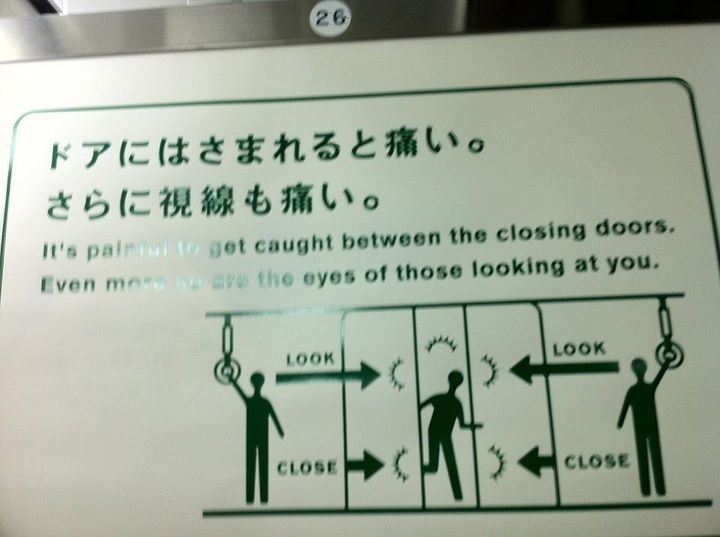Poka Yoke Subway Sign Examples – Can Humiliation be enough to prevent human errors?
There are numerous methods of preventing error or preventing defects. We discuss several of those in my series on Poka Yoke Examples. But, rarely, do we see an example of Poka Yoke where humiliation and embarassment was the primary method of preventing human error. Until now.
[contentblock id=32]
The subway sign below shows a passenger getting caught by the automated doors. The sign is mean to warn passengers not to get caught between the closing doors. The sign says the following:
It’s painful to get caught between the closing doors. Even more [painful] are the eyes of those looking at you.
In other words, it’s physically painful to get caught between closing doors at the subway. But, even worse, are the other passengers pointing their fingers at you because you were stupid enough to get caught between the closing doors.
That’s the overall message. It’s both descriptive and witty. But, would it help you avoid making this mistake?

I think the concensus is that the sign is witty, catches your attention, but ultimately it probably won’t prevent people from making this mistake.
What is interesting is the message about embarrassment and humiliation.
What do you think?








This is a very cultural form of poka yoke. Asians cultures are honor/shame based, and this is using the shame built into the culture (presumably Japanese, though I’m weak on identifying the different types of ideographs) to enforce something that’s a good idea. Americans are not particularly motivated by honor or shame and I don’t think this would be an effective presentation of the negative consequences to an American audience.
-John
Warning signs are, at best, the weakest form of error proofing. I wouldn’t really consider that sign a poka yoke.
I agree with Mark. This is a sign saying “be more careful” with a bit of explanation on why you should “be more careful”: otherwise people will look at you and wonder what went wrong with your upbringing to allow you to be so lame.
My standard for something being “mistake proofing” is there has to be a physical barrier (or software based… prevention) that prevents mistakes (maybe not all possible mistakes – but at least some).
“Warning” or training to “be more careful” may be warranted and useful, they just are not mistake proofing (in my mind). I actually think “mistake proofing” is something that is not very consistently understood (many people have different notions about what it means).
i think it wouldn’t work in Lithuania either..
I agree that this is not poka yoke.
Also, in a more advanced Lean culture (or Toyota culture) I think we would see very different things occuring. Process and person (training) would be at a high level, such that mistakes are few. Observing a mistake would be highly valued by the person who made it or first observed it at least, and by all others, too. This is because “catching” a mistake, even if one’s own, is a victory over poor quality. Now that it occured, albeit very rare, we can figure out why it occured and determine way/s to see that it never happens again. One potential tool to do that may be poka yoke.
So, in that environment, making and catchign a mistake is not an embarrassment but a victory … a perhaps necessary step along the continuous improvement (getting-ever-closer-to-perfection) path.
Here’s a comment from the Shingo Prize Linkedin Group:
Group: The Shingo Prize for Operational Excellence
Discussion: Poka Yoke Example: Prevent Error Through Embarrassment and Humiliation
I don’t see the sign as a poke yoke in any way. There are two methods of mistake-proofing a process. The first, and the most elegant way, is to make it impossible to make an error. Examples: make it impossible to miss assemble two parts by making the mating parts symetric to one on another; make the assembly fasteners for one part number different the those of another part number. The second mistrake proofing is to perform 100% detection inspection, where it is impossible to pass a defective part.
The sign does not fit either defintion of mistake proofing and as a result. Likely the cause of needing the sign in the first place is that the process (closing doors) often traps individuals who don’t know that the door is about to close on them.
Posted by Michael
this is not a poka-yoke but more of a shaming process. if you really wanted to correct the process of customer jumping in while closing doors you must have a barrier between the closing doors and the train platform that opens only when the train doors are open for a few seconds and then closes as the train door closes so that their is a time barrier between both doors . any one caught in between the two doors will wait for next train